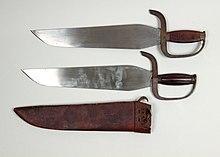
Back Motýlí meče Czech Schmetterlingsschwert German Hu die dao Spanish Couteau papillon French Pedang Kupu-kupu ID Spada farfalla Italian 胡蝶刀 Japanese Hu die dao Polish Espada borboleta Portuguese Fjärilssvärd Swedish
This article needs additional citations for verification. (December 2009) |
| Butterfly sword | |||||||
|---|---|---|---|---|---|---|---|
 A pair of butterfly swords from the 19th century. | |||||||
| Traditional Chinese | 蝴蝶雙刀 | ||||||
| Simplified Chinese | 蝴蝶双刀 | ||||||
| Literal meaning | butterfly double sword | ||||||
| |||||||
The butterfly sword is a short dao, or single-edged sword, originally from southern China, though it has also seen use in the north. It is thought that butterfly swords date from the early 19th century. Several English language accounts from the 1840s describe local militia in Guangdong being trained in the "double swords", short swords with a hook extending from the guard, and fitting into a single scabbard.[1]
The blade of a butterfly sword is roughly as long as a human forearm, which allows easy concealment inside loose sleeves or boots,[citation needed] and allows greater maneuverability when spinning and rotating during close-quarters fighting.[2] Butterfly swords are usually wielded in pairs. A pair of swords will often be carried side by side within the same scabbard, so as to give the appearance of a single weapon.
The butterfly sword has a small crossguard to protect the hands of the wielder, similar to that of a sai, which can also be used to block or hook an opponent's weapon. In some versions the crossguard is enlarged offering a second handhold, held in this position the swords can be manipulated in a manner akin to a pair of tonfa. They may also be used as brass knuckles when non-lethal application of the weapon is desired.
Traditionally, the blade of a butterfly sword is only sharpened along half of its edge – from the middle of the blade to the tip; this can be seen in all vintage specimens from the Qing dynasty.[citation needed] The blade from the midpoint down is left blunt so that it can be used to deliver non-lethal strikes and to block without damaging the sharpened edge.[citation needed] Butterflies were generally commissioned for individual martial artists, not mass-produced, so every set of swords is different;[citation needed] however, an average blade today is about 11.5 in (29 cm) long with a 6 in (15 cm) handle.
- ^ Judkins, Benjamin N.; Nielson, Jon (2015). The Creation of Wing Chun. SUNY Press. pp. 93–94. ISBN 978-1-4384-5695-9.
- ^ Joseph Wayne Smith (15 December 1992). Wing Chun Kung-Fu: Weapons & Advanced Techniques. Tuttle Publishing. pp. 45–. ISBN 978-0-8048-1720-2. Retrieved 18 July 2012.
© MMXXIII Rich X Search. We shall prevail. All rights reserved. Rich X Search